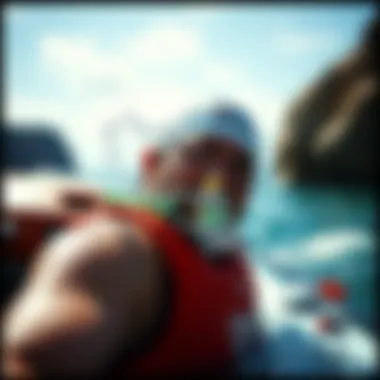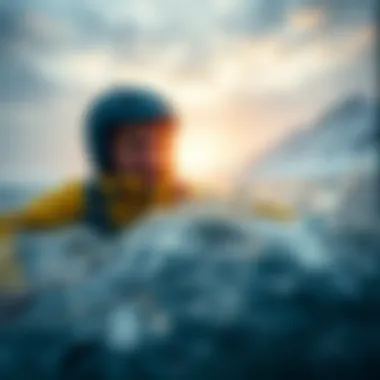Understanding Dehydration in Watersports: Key Insights


Intro
Dehydration is a subtle yet significant threat lurking beneath the surface, especially for those who thrive in the watersports scene. Surfers, paddleboarders, kitesurfers, and instructors alike often find themselves caught up in enjoying the thrills of their chosen sport, sometimes to the detriment of their hydration levels. In these exhilarating moments, it’s all too easy to overlook the importance of staying properly hydrated. Not only does dehydration stand to undermine performance, it can also pose serious safety risks in a water environment.
Understanding the signs of dehydration and methods to test hydration levels becomes indispensable for watersports enthusiasts. For instance, when you're out riding the waves under the scorching sun, an unnoticed drop in water levels can affect your energy, coordination, and judgment. Just like checking gear before heading out, keeping tabs on your hydration can be a game changer.
In this piece, we’ll explore how dehydration can sneak up on adventurous spirits, methods to keep track of hydration, and the aha moments that could turn the tide when it comes to endurance and safety on the water. Whether you’re a novice or an experienced athlete, this guide aims to elevate your awareness and help you sail smoothly through your aquatic endeavors.
The Importance of Hydration in Watersports
In the world of watersports, hydration plays an undeniably crucial role. When individuals participate in activities like surfing, paddleboarding, or kitesurfing, they are sometimes so focused on the thrill or the technique that they overlook the importance of keeping well-hydrated. That's a slippery slope that can lead to trouble.
Understanding Hydration
Hydration isn’t just about drinking water; it’s about maintaining the right balance of fluids in the body. For those who spend extended hours outdoors, especially in sunny or windy conditions, understanding what hydration truly means is essential.
When we engage in rigorous activities, we sweat. Each drop carries with it electrolytes, essential minerals like sodium, potassium, and magnesium that our bodies need to function properly. If these minerals are not replaced alongside fluid losses, it can result in imbalances that affect both performance and health.
A good way to gauge hydration levels is to pay attention to the color of urine. Clear or light yellow indicates adequate hydration, while dark yellow can signal dehydration. However, subjective measures can sometimes be misleading, so it’s critical to approach hydration from multiple angles.
The Role of Water in Physical Performance
Water serves as the medium through which numerous physiological processes occur. Think of it as fuel for a finely tuned machine. When you're well-hydrated, the blood volume rises, allowing nutrients and oxygen to be efficiently transported to muscles. This, in turn, enhances stamina and strength during demanding athletic endeavors.
Moreover, adequate hydration aids in regulating body temperature. During high-energy activities like kite surfing, where sun exposure can be intense, maintaining optimal body temperature is crucial. Water helps disperse heat, reducing the risk of heat-related illnesses, which can be all too common among watersport enthusiasts.
In addition to these physical advantages, the cognitive aspect shouldn’t be overlooked. Dehydration can hamper concentration and reaction times, leading to poor decision-making on the water. That's a double whammy for someone navigating waves or altering the course of a paddleboard race.
To sum up, the significance of hydration in watersports cannot be overstated. Staying hydrated not only enhances physical performance but also safeguards against heat stress and enhances cognitive function. Watersports participants owe it to themselves—and their safety— to make hydration a top priority during every aquatic adventure.
"Hydration is not just a personal choice; it's a necessity for those who want to excel in watersports."
Whether you're a seasoned pro or just dipping your toes in, grasping these concepts will set the stage for safer, more enjoyable experiences in the water.
What Is Dehydration?
Understanding dehydration is paramount for watersports enthusiasts. When you're out riding the waves or paddling fiercely, your body loses water at a rapid pace, often without you even noticing. This section delves into the very essence of dehydration—what it means, how it manifests, and what it can cost you in terms of performance and safety. By grasping these concepts, you can better equip yourself to maintain optimal hydration levels.
Defining Dehydration
Dehydration occurs when your body loses more fluids than it takes in. This imbalance can happen gradually, sneaking up on you, especially in demanding environments like beaches or lakes where you might focus more on the fun than on drinking water. To put it simply, when your body lacks the necessary water to function correctly, it starts to show signs of distress.
The body primarily relies on water to carry out crucial functions such as regulating temperature, lubricating joints, and even transporting nutrients. When dehydration sets in, the consequences can range from mild discomfort—like feeling a tad sluggish—to severe impairments that could hinder your ability to maneuver on a surfboard or paddle effectively.
Different Levels of Dehydration


Dehydration is not a one-size-fits-all condition; it varies in severity. Here’s a breakdown that shows how it can differ:
- Mild Dehydration: At this stage, you might experience slight thirst and a dry mouth. It can sneak up on you after a few vigorous hours in the water, leaving you feeling a bit off but not incapacitated.
- Moderate Dehydration: This is where the rubber meets the road. Symptoms become more pronounced. You may encounter fatigue, headache, dizziness, and a noticeable decline in performance. It’s like having a flat tire on your favorite board—halfway empty just won't cut it.
- Severe Dehydration: Here we’re talking a serious overhaul that can land you in trouble. The symptoms escalate and may include rapid heartbeat, confusion, and in extreme cases, loss of consciousness. At this point, immediate medical attention is necessary, as it poses a significant risk to your health and safety.
Remember, avoiding dehydration is cheaper than treating it. It's like putting on sunscreen before catching the rays; prevention is key.
It's crucial to stay aware of your hydration levels, especially during prolonged exposure to sun and physical exertion. By understanding these levels, watersports enthusiasts can make informed decisions to keep themselves safe and at peak performance.
Symptoms of Dehydration
Dehydration isn't just a sideline issue; it’s a game-changer for those who love to ride the waves or paddle in open water. Understanding the symptoms of dehydration helps sailors, surfers, paddleboarders, and other watersports enthusiasts to maintain their performance and safety. Making the distinction between mild discomfort and serious danger can mean the difference between finishing a session strong or needing an ambulance.
Monitoring hydration levels during water activities can often be overlooked. Yet, spotting dehydration symptoms early can prevent a cascade of complications. Better hydration awareness leads to improved performance, safer adventures, and makes it easier to enjoy those sunny days on the water.
Early Signs and Indicators
The body tends to send subtle warning signals before severe symptoms arise. If you know what to look for, you can catch dehydration in its infancy. Here are some early signs to watch out for:
- Thirst: This might seem obvious, but thirst is often the first and most straightforward indicator that your body needs more fluids.
- Dry Mouth and Lips: A parched feeling in your mouth or cracking on your lips could suggest you need to hydrate.
- Decreased Urine Output: If you’re not hitting the restroom as often as normal, take this as a red flag.
- Dark Yellow Urine: A quick glance at the color can be telling. Clear or light yellow indicates good hydration, while dark colors suggest a need for more fluids.
- Fatigue or Lethargy: Feeling a bit sluggish? It might not be just the waves; you could be in need of a drink.
Catching these signs early on allows watersports enthusiasts to take immediate action, whether that be stopping for a hydration break or consuming electrolyte-rich drinks. Staying ahead of dehydration is crucial for maintaining energy and focus, allowing you to ride the swell with renewed vigor.
Severe Symptoms of Dehydration
Ignoring the early signs can lead to much graver consequences. Severe dehydration can pose serious risks that can cut your fun short or even lead to dangerous scenarios. Here’s what to keep an eye out for:
- Confusion or Dizziness: If you start to feel disoriented or light-headed, it’s a strong signal to get some fluids into you, fast.
- Rapid Heart Rate: An increased heart rate can be your body's way of compensating for low fluid levels.
- Nausea: This can be particularly detrimental for those enjoying water sports, as nausea might lead to vomiting, offering no help in rehydration.
- Lack of Sweating: An unusual absence of sweat while being active in the heat is a clear indicator of severe dehydration.
- Extreme Fatigue: If you're unable to muster the energy to continue, reconsider your hydration strategy immediately.
"Recognizing the transition from simple thirst to confusing bodily signals could save a day on the water."
Catching severe symptoms too late can require medical intervention and end any plans for a fun-filled day on the water. Watersports enthusiasts are encouraged to remain vigilant and proactive about hydration to prevent their beloved activities from becoming a chore or, worse, a hazard.
Is There a Test for Dehydration?
Understanding dehydration is not just about feeling thirsty; it’s essential for anyone engaged in watersports. This section delves into the significance of testing for dehydration. Accurate testing methods can help teams and enthusiasts recognize hydration issues before they escalate into serious health concerns. Evaluating your hydration levels during training or competition helps maintain peak performance.
Common Methods of Assessing Hydration
Assessing hydration is of utmost importance for athletes. There are several strategies that can be employed:
- Visual Assessment: Simply eyeing your urine can reveal a lot. Dark yellow urine usually suggests dehydration, while light yellow indicates adequate hydration.
- Body Weight Measurement: Weighing before and after activities can show how much fluid has been lost. A drop in weight of more than 2% post-exercise signals a need to replenish.
- Thirst Level: Though subjective, thirst is a reliable indicator. If you feel thirsty, it’s best to hydrate.
- Skin Turgor Test: Pinching the skin on the back of your hand provides insight into hydration levels. If the skin takes time to return to its normal state, dehydration might be present.
Field Tests for Hydration Levels
When in the throes of sport, sometimes you don’t have access to complex equipment. Here are some practical field tests:
- Urine Color Chart: Carry a color chart to compare urine with established shades that represent hydration levels. This visual guide can be extremely helpful on the go.
- Hydration Strips: These strips react to hydration biomarkers found in your saliva. You can quickly use them during downtime.
- Time Trials: For more objective data, track performance changes in speed or endurance, which can be affected by hydration status.


Laboratory Testing Options
If you need a more thorough assessment, laboratory tests can provide an accurate picture of your hydration status:
- Blood Tests: These can measure various markers, such as electrolytes and blood volume, which directly indicate hydration levels.
- Urine Specific Gravity Test: Conducted in a lab, this measures the concentration of particles in urine, providing insights into hydration.
- Osmolality Testing: This test assesses the concentration of solutes in body fluids to give an excellent overview of your hydration state.
Quote: "Keeping tabs on your hydration through regular testing can be the difference between stellar performance and hitting a wall."
Practical Hydration Strategies for Watersports
Staying hydrated is not just about drinking a glass of water now and then. For those who revel in the thrill of watersports, whether it be surfing, paddleboarding, or kitesurfing, understanding and implementing practical hydration strategies becomes critical for performance and safety. Dehydration can sneak up on you faster than a rogue wave, and its effects can undermine your experience on the water. This section explores actionable strategies to ensure maximum hydration before, during, and after your aquatic adventures.
Pre-Activity Hydration Recommendations
Prior to hitting the water, it’s essential to start the day on the right foot—preferably with a glass of water or a hydrating beverage. Begin hydrating at least a few hours before you engage in any watersport. This approach can make a world of difference. Dehydration sets in before you even step onto your board or kayak, often without you realizing it. Here’s a straightforward guide to getting your hydration game on point:
- Hydrate Gradually: Begin drinking water a few hours before starting your activity. Avoid gulping down a massive amount of water at once; it might lead to discomfort.
- Electrolytes Matter: Consider consuming a beverage with electrolytes. Coconut water or a sports drink can replenish vital minerals lost through sweat. Look for options without excessive sugars, which can, ironically, dehydrate you.
- Test the Color: Paying attention to the color of your urine can be quite telling. A pale yellow indicates proper hydration, while dark urine suggests you need to drink up.
During Activity Hydration Techniques
When you’re in the thick of it, maintaining your hydration is crucial. Here are some techniques to incorporate while you're out in the swell:
- Frequent Sips: Take small sips of water or hydrated beverages consistently throughout your activity, rather than guzzling a large amount all at once. Every 15 to 30 minutes can be a good rule of thumb.
- Water-Friendly Solutions: Consider using a hydration pack or water bottle that can attach to your board or equipment. This accessibility means you’re less likely to forget your hydration during your session.
- Observe Your Body: If you begin to feel fatigued, dizzy, or excessively thirsty, it's a clear signal your body is in need of fluids. Don’t wait; reach for your drink immediately.
Post-Activity Recovery Hydration
After a rigorous day spent riding the waves, your hydration strategy shouldn’t just end when you dry off. Proper recovery is key to avoiding potential pitfalls of dehydration:
- Replenish Quickly: Drink water or a recovery beverage soon after finishing your watersport activity. This helps to counteract the fluids you lost.
- Snack Smartly: Combine hydration with nutrition. Consuming fruits like oranges or watermelon, which have high water content, can assist in replenishing lost fluids while also providing nutrients essential for recovery.
- Track Your Intake: As you engage in various aquatic activities, keeping a log of your water intake can aid in better understanding your hydration needs. This is especially helpful if you intend to push your limits on longer days out on the water.
Staying hydrated is as crucial as the skills you bring to your watersports. Paying attention to your body's signals and planning ahead can make a significant difference in your performance and overall enjoyment.
Implementing these hydration strategies doesn’t just enhance your performance; it safeguards your health while engaging in the watersports you love. It’s all about finding a balance that works for you—and it starts with a simple glass of water.
Consequences of Ignoring Hydration
Ignoring hydration when engaging in watersports can spell trouble for both performance and overall health. This section delves into the repercussions that stem from neglecting hydration, framing it in a manner that resonates with watersports enthusiasts. Grasping these consequences is paramount not just for achieving peak performance but also for ensuring safety in aquatic activities.
Impact on Performance
When you’re out on the waves, the last thing on your mind might be your fluid intake. However, dehydration can significantly hinder your ability to perform at your best. The body relies on water for numerous functions, and when it lacks adequate hydration, your strength, endurance, and agility may take a nosedive.
When dehydration sets in, you could experience:
- Decreased stamina: Even mild dehydration can lead to fatigue faster than you might expect. What once felt like a breeze can suddenly become an arduous task.
- Compromised cognitive function: Staying focused is key, especially in dynamic environments such as surfing or paddleboarding. Dehydration can cloud your judgement and reaction times.
- Muscle cramps: If you’ve ever experienced a painful cramp while out in the water, dehydration might be partly to blame. Your muscles require water and electrolytes to function optimally.
- Impaired balance and coordination: For activities that require precision like kitesurfing, losing your balance can be detrimental. Dehydration can disrupt your body’s neuromuscular functions and leave you feeling unsteady.
"Hydration isn’t just about drinking water; it’s about maintaining your body’s balance for optimal performance."


Health Risks Associated with Dehydration
Ignoring hydration isn’t just a performance issue—it can lead to serious health risks that should not be taken lightly. While watersports can be exhilarating, they come with the inherent risks of exposure to the elements, and dehydration adds another layer of danger.
Some notable health risks include:
- Kidney problems: The kidneys depend on adequate fluid to filter waste. Prolonged dehydration can stress these organs, potentially leading to kidney stones or dysfunction.
- Heat-related illnesses: When you're out in the sun, the risk of heat exhaustion or heatstroke increases if you're not properly hydrating. The body needs water to regulate temperature.
- Electrolyte imbalance: Hydration isn't only about water; it's also about maintaining a balance of essential salts in the body. Losing too much fluid can skew this balance and prompt serious complications.
- Confusion and fainting: In severe cases, dehydration can result in confusion, dizziness, and even fainting spells. This poses a significant risk, especially when you’re surrounded by water.
Taking hydration seriously is not just about enhancing performance but safeguarding one’s health in demanding aquatic environments. Awareness of these potential consequences can empower watersports enthusiasts to prioritize their hydration and keep both performance and safety in check.
Innovations in Hydration Monitoring
In the realm of watersports, where precision and performance are often at the forefront, monitoring hydration has evolved into a crucial element for ensuring safety and enhancing competitive edge. Modern technological advancements have shifted the paradigm from basic hydration awareness to sophisticated monitoring solutions that empower athletes. This section will delve into the importance of monitoring innovations, highlighting specific elements such as wearable technology and mobile applications that optimize hydration management for watersports enthusiasts.
With increasing participation in activities like surfing, paddleboarding, and kitesurfing, staying hydrated isn't just a matter of grabbing a drink now and then. The significance of hydration monitoring lies in its ability to provide real-time insights into hydration levels, thus allowing sports participants to make informed decisions. Ignoring hydration can lead to compromised performance and serious health risks. Therefore, innovations in hydration monitoring address these significant areas by offering reliable and user-friendly tools that can help sailors, surfers, and instructors maintain optimal fluid balance.
Wearable Technology for Hydration Tracking
The advent of wearable technology has ushered in a new era of personalized health monitoring, and hydration tracking is no exception. These gadgets, often worn as wristbands or integrated into sports clothing, use various sensors to assess body temperature, sweat rate, and heart rate which correlate closely with hydration status. By collecting data during intense activity, these devices can notify users when it’s time to rehydrate.
Key Benefits of Wearable Hydration Trackers:
- Real-Time Monitoring: Immediate feedback can alert users before the onset of dehydration-related symptoms, fostering proactive hydration efforts.
- Data Insights: Users gain access to historical hydration patterns over time, enabling them to adjust their fluid intake based on activities.
- Integration with Other Health Metrics: Many devices can link hydration data with other fitness metrics, creating a comprehensive view of wellbeing.
However, it is essential to consider certain limitations. Wearable devices may vary widely in accuracy, and users must ensure that the technology fits well with their specific sport and is compatible with other equipment. Over-reliance on these gadgets without intuitive understanding can lead to suboptimal hydration practices, making education alongside technology critical.
Mobile Apps for Hydration Management
As smartphones increasingly become an integral part of the daily lives, mobile applications dedicated to hydration management have gained traction among watersport lovers. These apps are typically designed to track fluid intake, set reminders for hydration, and even calculate optimal fluid requirements based on various factors like weight, weather, and type of activity.
Notable Features of Hydration Management Apps:
- Customizable Reminders: Users can set alerts to drink water at designated intervals, tailoring notifications to fit individual schedules.
- Integrated Nutrition Tracking: Some applications feature nutritional databases to assess daily water intake alongside other food consumption, giving a well-rounded approach to hydration.
- Community Features: Users can join groups or challenges, creating a sense of community and motivation to improve hydration habits together.
An important factor to keep in mind when using apps is the need for user input. Many apps depend on manual logging of water intake, creating a potential burden. This could lead to under-reporting or inaccurate tracking if the user fails to log consistently. While apps offer useful guidance, the real engagement is in developing an understanding of one’s body needs vis-a-vis hydration.
"Hydration isn’t merely about filling a cup; it's about understanding how your body communicates its needs through activity."
In summary, innovations in hydration monitoring through wearable tech and mobile applications represent a significant leap forward for athletes in the watersports domain. These tools enable enthusiasts to navigate the fine line between performance and safety by keeping hydration at the forefront of their activities.
End
In this age, where every drop counts, understanding the role of hydration in watersports cannot be emphasized enough. The need to maintain optimal hydration levels emerges as paramount, especially when engaging in high-energy aquatic activities like surfing, paddleboarding, or kitesurfing. This article sheds light on the essential aspects of dehydration, from recognizing symptoms to implementing effective hydration strategies.
Summarizing the Importance of Hydration
Maintaining proper hydration shouldn't be viewed as a trivial matter; it’s fundamental for peak performance and safety. Dehydration can sneak up like a thief in the night, often going unnoticed until it’s too late.
When you're out there on the waves, feeling the wind whip against your face, your body is also working overtime. Insufficient water intake can lead to fatigue, decreased coordination, and even serious health risks. Here are some critical points to consider regarding hydration:
- Physical Performance: Staying hydrated helps your muscles work more efficiently. Even mild dehydration can lead to noticeable drops in strength and endurance.
- Cognitive Function: Clear thinking is vital when navigating waterways or teaching others. Hydration aids in maintaining focus and swift decision-making.
- Health Risks: Ignoring hydration can lead to severe consequences, ranging from heat exhaustion to heat stroke. With the right knowledge, you can avoid these pitfalls.
- Recovery: After an intense session, coaching those involved in watersports on proper recovery hydration techniques can greatly enhance their recovery process.
"Hydration is not just about drinking water; it's about understanding the body's signals and responding to them."



